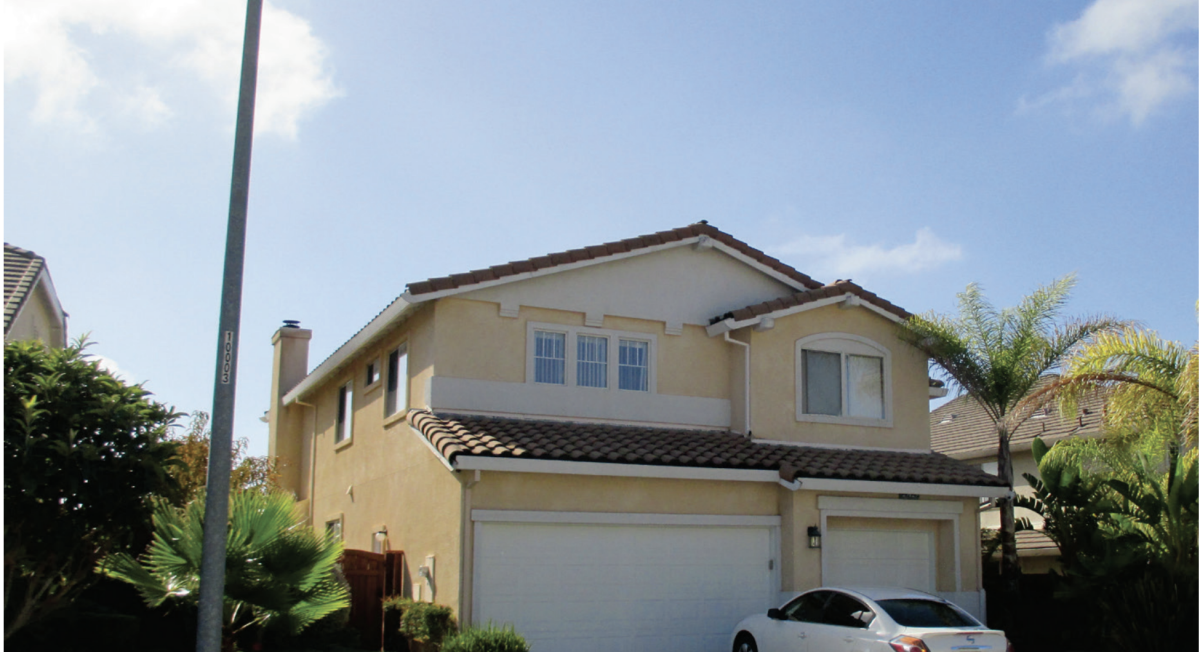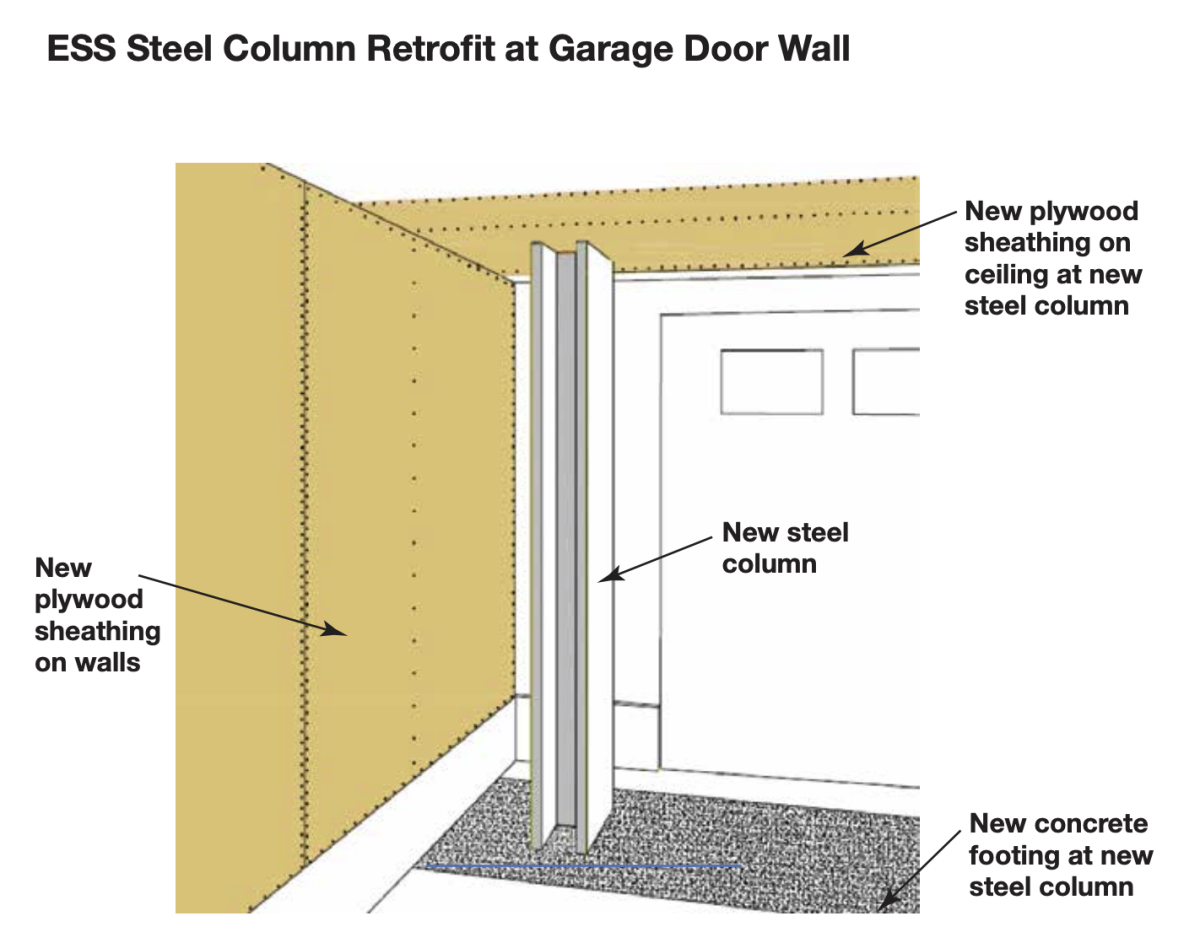The hidden earthquake danger lurking inside California homes and what you can do about it

- Share via
There could be hidden earthquake flaws in your single-family home in California — enough to be ruinous and possibly deadly in the next big earthquake.
One of the dangers may come as a surprise to homeowners, as even relatively newer homes may have this defect.
The soft-story seismic defect in houses
Built before 2000, they’re known as “soft-story” homes — single-family homes with a living space over a garage. They’re vulnerable to collapse because the upper floor is held up only by skinny, flimsy supports that can bend or break in a quake, causing a living room or a bedroom to come crashing down on the garage.

Strengthening a garage to repair the collapse defect is fairly straightforward. It involves installing a single steel column or one or two specially engineered walls that are 12 to 18 inches wide, made from either steel or wood and act like columns. They’re designed to resist the side-to-side shaking that comes with an earthquake.

The other dangerous type of houses are those with a “cripple wall” — a flimsy, short wall that creates a crawl space underneath the main part of the home.
The crawl space seismic defect
Because the home hasn’t been fastened tightly to the foundation, the house can slide or topple off its foundation in an earthquake, potentially leading to hundreds of thousands of dollars in damage.
These homes were typically built before 1980, and especially before 1940. The fix is designed to brace the flimsy wall with plywood and have the foundation bolted to the frame of the house — a retrofit nicknamed “brace and bolt.”

California officials have been trying to raise awareness of homes with soft story and crawl space defects for years.
Now, they’re again asking homeowners to look hard at whether their home has this flaw — and offering up money to assist them to pay for a seismic retrofit.
Grants available to owners of soft-story homes
This month, the California Residential Mitigation Program opened up applications for homeowners for grants of up to $13,000 to address a soft story retrofit for their single-family home. People can apply at earthquakesoftstory.com.
Getting the maximum grant amount would pay for about half the cost of a typical retrofit, which averages about $20,000 to $25,000. Repairing a severely damaged single-family home could cost hundreds of thousands of dollars or more.
But should this type of retrofit become more popular, “I would imagine that we’d start to see the prices come down,” said Janiele Maffei, a structural engineer and chief mitigation officer for the California Earthquake Authority.
Funded by a $5-million grant from the Federal Emergency Management Agency, the idea is to get homeowners to retrofit now, before the next devastating earthquake.
Falling cost of retrofits
The cost of a soft-story retrofit for single-family homes has already fallen in recent years. FEMA published pre-engineered retrofit plans in 2019 that allow many homeowners to implement seismic strengthening without a structural engineer, saving a couple of thousand dollars.
Officials started allowing residents to apply for the soft-story single-family house retrofit grants in early 2023. At the time, only residents of 82 ZIP Codes in Los Angeles, Pasadena, San Francisco, Oakland and Berkeley were eligible. The initial grant window was open for only about a month.
But starting Oct. 15, the program opened for applications again, and this time it won’t close until the money runs out. And far more homeowners — in 209 ZIP Codes — are eligible to apply, across a wide swath of Southern California, such as from Long Beach to Santa Clarita, Redondo Beach to Pomona, and Glendale to East Los Angeles to West Covina.
In Northern California, eligibility has also expanded to include ZIP Codes in cities such as Fremont, Hayward, San Leandro, Livermore, Pleasanton and Alameda.

Help for owners of homes with crawl spaces
For homes with crawl spaces, retrofits are generally simpler and cheaper compared to those that have a soft story. Owners of homes with crawl spaces are eligible for grants of up to $3,000 through the “Earthquake Brace + Bolt” program. (Up to $7,000 in additional money is available to homeowners with an annual income at or below $87,360.)

Older California homes can slide or topple off their foundations in an earthquake. Structural engineer Janiele Maffei offers advice on what precautions should be taken to retrofit such homes.
The cost to retrofit homes with a crawl space, on average, is about $5,200.
People can sign up to be notified when registration opens again in January at earthquakebracebolt.com. The last time registration was open earlier this year, grants were available to homeowners in 815 ZIP Codes, with 300 new ZIP Codes added to the eligibility list. Besides the Southern California metro area and the San Francisco Bay Area, other eligible areas are in places such as San Diego, Palm Springs, Santa Barbara, Monterey and Salinas.

More than 27,000 homes have been retrofitted using Brace + Bolt grants since the program’s inception a decade ago.
New funding coming for soft-story apartments
The California Residential Mitigation Program also hopes to launch a new program to offer financial help for owners of smaller apartment buildings — between five and 10 units — that have a soft-story defect. These are apartment buildings with carports, garages or retail stores on the ground floor, with flimsy supports that can collapse in the side-to-side shaking of an earthquake.

Why apartments can collapse in an earthquake. Flimsy ground story walls for carports, garages or stores can crumble in an earthquake, and are called “soft-story” buildings, explains U.S. Geological Survey geophysicist Ken Hudnut.
Sometime in 2025, officials hope to offer up grants to apartment owners in cities that already have mandatory retrofit laws for these buildings. The initial focus will be on areas with socially vulnerable populations, Maffei said.
Soft-story apartments have been a killer in past earthquakes. During the predawn magnitude 6.7 Northridge earthquake of 1994, 16 people died when their apartments collapsed. Soft-story apartments also suffered deadly collapses in San Francisco during the magnitude 6.9 Loma Prieta earthquake of 1989.
The soft-story apartment grant program received $40 million from a FEMA grant.
Southern California cities that have passed mandatory soft-story retrofit ordinances include Los Angeles, Torrance, Pasadena, Santa Monica, Culver City, West Hollywood and Beverly Hills. In Northern California, San Jose just passed a mandatory soft-story order, joining other cities such as San Francisco, Oakland, Berkeley, Fremont and Mill Valley.
More to Read
Sign up for Essential California
The most important California stories and recommendations in your inbox every morning.
You may occasionally receive promotional content from the Los Angeles Times.











